says
ok, I will go back and make sure you have access.
Be...
Observation on blade designs of various well-known brands(controversial...probably)
- Thread starter nivekkan
- Start date
You are using an out of date browser. It may not display this or other websites correctly.
You should upgrade or use an alternative browser.
You should upgrade or use an alternative browser.
says
Spin and more spin.
says
Spin and more spin.
Well-Known Member
Super Moderator
I agree with Carl but the Viscaria plays infinitely better.
About 7 years ago I had a black tag Viscaria. I got it for almost nothing: $50.00. I sold it to a MyTT member who came from Netherlands to visit NYC.
I wasn't thinking of selling it. But Smash_Fan told him I had it and he said he wanted to buy it. I had him try it and play with it first. And then he asked how much I wanted. I sold it for $70.00.
I know, I could have sold it for a lot more because of the black tag. But it wasn't the right blade for me and this guy loved it. As far as I was concerned, that was a reasonable price and it was nice to see the blade go to someone who would really put it to good use.
Koto is a little too hard for me.
But Viscaria is one of the best blades ever made. And I do think it has one of my top 2 or 3 favorite handles.
Last edited:
This user has no status.
This user has no status.
Active Member
The photos of my handle show that there are 4 plies on each side of the handle. So, 8 total if you don't count the 5 plies of the blade face. 13 if you do.
The photo of the Viscaria has 5. (10 for both sides, 17 with the plies of the blade). So, the Viscaria's handle actually only has one more ply on each side of the handle.
I would say, without question, I like a Viscaria handle, but nowhere near as much as the OSP handle. And the OSP handle is made of wood that is so much better than the wood of any mass produced blade I have tried. Those little dings I have gotten on my OSP handle would have resulted in massive chunks from a Viscaria's handle.
Oh, im referring to the vertical strips actually. You see, the top surface of the virtuoso handle is a single piece of a dark wood, and below that, there is a single piece of a lighter wood, and so on. While the top surface of Viscaria, is composed of lots of 1mm stripes of wood that form the horizontal greyish piece, and below that, lots of stripes of wood that form the whitish layer.
Not sure if I explained it better this time.
By the way, if you look at the picture of the Viscaria you talking about for a feel seconds, it will become a Korbel
says
Spin and more spin.
says
Spin and more spin.
Well-Known Member
Super Moderator
Oh, im referring to the vertical strips actually. You see, the top surface of the virtuoso handle is a single piece of a dark wood, and below that, there is a single piece of a lighter wood, and so on. While the top surface of Viscaria, is composed of lots of 1mm stripes of wood that form the horizontal greyish piece, and below that, lots of stripes of wood that form the whitish layer.
Not sure if I explained it better this time.
By the way, if you look at the picture of the Viscaria you talking about for a feel seconds, it will become a Korbel
That is the grain of the wood. Not the plies. And that was switched about 5 years ago. When they first switched to having the grain vertical instead of horizontal, there were a lot of people who worried that the new way was worse.
It still makes very little difference though.
says
Spin and more spin.
says
Spin and more spin.
Well-Known Member
Super Moderator
Images lifted from this thread:
http://mytabletennis.net/forum/sold-viscaria-black-tag_topic74317.html
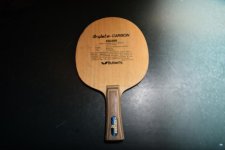
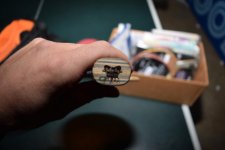
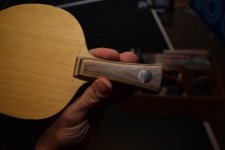
Those are photos of a Viscaria with the grain the normal way. When the grain is vertical like in the new Viscarias, it definitely makes that ply of the handle weaker and more subject to chipping.
You will never see normal ply wood with the grain vertical like that because the planks of ply wood would break amazingly easily.
http://mytabletennis.net/forum/sold-viscaria-black-tag_topic74317.html



Those are photos of a Viscaria with the grain the normal way. When the grain is vertical like in the new Viscarias, it definitely makes that ply of the handle weaker and more subject to chipping.
You will never see normal ply wood with the grain vertical like that because the planks of ply wood would break amazingly easily.
Last edited:
This user has no status.
This user has no status.
Active Member
You sure it is just grains and not plies? I always had the idea that the handles were made like this:That is the grain of the wood. Not the plies. And that was switched about 5 years ago. When they first switched to having the grain vertical instead of horizontal, there were a lot of people who worried that the new way was worse.
It still makes very little difference though.
(just skip through the video and you will get the idea)
This user has no status.
This user has no status.
Active Member
That is the grain of the wood. Not the plies. And that was switched about 5 years ago. When they first switched to having the grain vertical instead of horizontal, there were a lot of people who worried that the new way was worse.
It still makes very little difference though.
Anyways, going back to the topic from here:
I think this switch was good aesthetically.
Sure you could have good looking handles like this one:

But if you’re not lucky, you could have a handle that look like a toe nail:

Last edited:
says
Spin and more spin.
says
Spin and more spin.
Well-Known Member
Super Moderator
By laminated wood I’m referring to the majority of handles that are made of “strips” of wood glued together to make a piece, instead of actual solid wood, like Virtuoso and the ones you posted.
Like this:
View attachment 19812
I have the impression that these would deal better with sweat absorption, but that’s only a guess.
You sure it is just grains and not plies? I always had the idea that the handles were made like this:
(just skip through the video and you will get the idea)
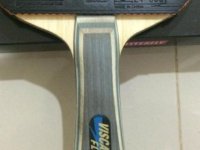
I am beyond 100% sure. I remember when they announced that they were going to do this. That grey piece that has the Viscaria tag in it is one piece. The grain is simply lined up to vertically instead of horizontally.
This user has no status.
I'm sorry Carl but lVegita is right. The wood that big brands use in the handles is basically thin veneers that are pre-dyed and then glued together. The wood is cut in the perpendicular direction so that the grain is oriented vertically. They used to do this but with bigger chunks of wood 1-2mm thick and the plies were horizontal like you see in the Korbel and old Viscarias. Nowadays they use thinner strips and align them vertically to get a more uniform look.
This user has no status.
This user has no status.
Member
But if you’re not lucky, you could have a handle that look like a toe nail:


That is funny. looks like one with fungal infection too.
This user has no status.
This user has no status.
Member
I have only seen wood handle that has tiny creases(is it called the grain?) oriented in the direction of the blade.I'm sorry Carl but lVegita is right. The wood that big brands use in the handles is basically thin veneers that are pre-dyed and then glued together. The wood is cut in the perpendicular direction so that the grain is oriented vertically. They used to do this but with bigger chunks of wood 1-2mm thick and the plies were horizontal like you see in the Korbel and old Viscarias. Nowadays they use thinner strips and align them vertically to get a more uniform look.
This user has no status.
I have only seen wood handle that has tiny creases(is it called the grain?) oriented in the direction of the blade.
The grain is almost always oriented vertically, but that's a different thing. You have the orientation of the wood grain and the orientation of the cut.
Older blades have very simple patterns in the handle, usually just horizontal or vertical stripes. These were just 1-2mm thick wood plies glued together. But the wood wasn't dyed, except in some cases like clipper, because it's very hard to dye wood all the way trough. To make an handle piece you first have a block, then you shape it to desired form. So you need to have consistent color all the way trough, so when you remove material the color is still there. But is very hard to achieve this, to get the dye inside the piece you have to use vacuum chambers, which is costly and time consuming.
Nowadays they have what is called reconstituted wood, or fineline. They use thin sheets of wood which are much easier to dye, and glue them together to make bigger pieces. So they end up with blocks of wood with uniform color, which then they cut in the perpendicular direction. They usually use ayous for this because is soft, cheap and has a neutral color so it absorbs the wood dye very well. And this is how they are able to make those intricate patterns on the modern handles.
This user has no status.
This user has no status.
Member
The grain is almost always oriented vertically, but that's a different thing. You have the orientation of the wood grain and the orientation of the cut.
Older blades have very simple patterns in the handle, usually just horizontal or vertical stripes. These were just 1-2mm thick wood plies glued together. But the wood wasn't dyed, except in some cases like clipper, because it's very hard to dye wood all the way trough. To make an handle piece you first have a block, then you shape it to desired form. So you need to have consistent color all the way trough, so when you remove material the color is still there. But is very hard to achieve this, to get the dye inside the piece you have to use vacuum chambers, which is costly and time consuming.
Nowadays they have what is called reconstituted wood, or fineline. They use thin sheets of wood which are much easier to dye, and glue them together to make bigger pieces. So they end up with blocks of wood with uniform color, which then they cut in the perpendicular direction. They usually use ayous for this because is soft, cheap and has a neutral color so it absorbs the wood dye very well. And this is how they are able to make those intricate patterns on the modern handles.
That is a detailed explanation
This user has no status.
That is a detailed explanation. Is there any durability or comfort compromise with the modern method?
Durability wise the "old" method was better. You look at some vintage blades and you can see the handles aged very well, in some of them the wood even turned darker and more beautiful. Because ayous is soft it is more susceptible to physical damage and it also absorbs more moisture. That's why these handles tend to look dull after some use. Regarding comfort it's all about personal opinion. Some prefer the softer feel and others prefer harder woods for the handle.
says
Spin and more spin.
says
Spin and more spin.
Well-Known Member
Super Moderator
Perhaps it is a language thing. But there are 5 plies per side in the new Viscaria handle. Not thousands.
This user has no status.
Perhaps it is a language thing. But there are 5 plies per side in the new Viscaria handle. Not thousands.
Yes, there are 5 plies, but within those plies you have multiple vertical lines because of the thin glued layers. Let's see if this pic helps. The black lines are the layers that are glued together, then they are are cut vertically (green lines).
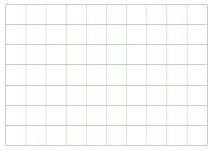
says
Spin and more spin.
says
Spin and more spin.
Well-Known Member
Super Moderator
Yes, there are 5 plies, but within those plies you have multiple vertical lines because of the thin glued layers. Let's see if this pic helps. The black lines are the layers that are glued together, then they are are cut vertically (green lines).
View attachment 19823
Okay. Maybe you are right.
Seems like a silly process to me to make the handle that way. But I could be wrong.
This user has no status.
Okay. Maybe you are right.
Seems like a silly process to me to make the handle that way. But I could be wrong.
It's silly if you think of blades like viscaria, they could just glue the plies together. But as you said, this way they can get a more uniform look and there is less deviation on the weight of the handles because the wood is more homogeneous. In other cases, like the pattern in TB ALC, it would be impossible to mass produce without using this method.
This user has no status.
This user has no status.
Active Member
I guess you skipped the video I posted, it illustrates what we were trying to say:Okay. Maybe you are right.
Seems like a silly process to me to make the handle that way. But I could be wrong.
says
Spin and more spin.
says
Spin and more spin.
Well-Known Member
Super Moderator
I guess you skipped the video I posted, it illustrates what we were trying to say:
I watched a very short amount of the video. But I know how plies are constructed.
What I did was look closely at my TB ZLF handle and decided that does look like it could be how it was done.
BTW: that many plies laminated would actually make the wood absorb less sweat rather than more, because of the glue between plies. And it makes it so there are that many more places where the plies could delaminate. Sweat can cause ply delimitation.
But Butterfly handles seem to work. Just not as well as my OSP handle.
Similar threads
- Replies
- 14
- Views
- 740
- Replies
- 14
- Views
- 480
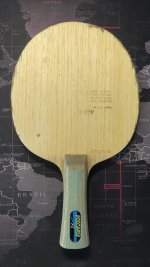
- Replies
- 0
- Views
- 134
- Replies
- 21
- Views
- 1K










